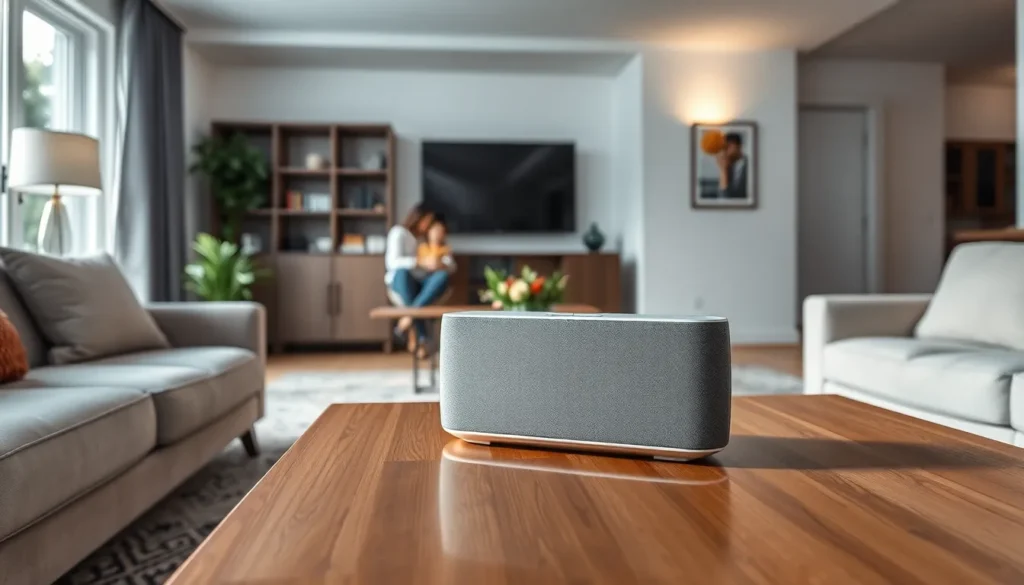Smart speakers have become the life of the party in homes everywhere, and not just because they can play your favorite tunes. With a simple voice command, they can dim the lights, set reminders, or even order pizza—because who wants to get off the couch? These little gadgets pack a punch with features that make daily tasks feel like magic.
Table of Contents
ToggleOverview of Smart Speaker Features
Smart speakers integrate several features, enhancing user convenience. Voice-activated assistants perform tasks like adjusting thermostats, managing calendars, and providing weather updates. Users engage with these devices either casually or through structured routines.
Music playback remains a primary function; however, smart speakers also support various streaming services. Devices offer personalized playlists and recommendations based on user preferences. Compatibility with different platforms allows seamless access to a wide range of audio content.
Home automation represents another pivotal feature. Users can control compatible devices such as lights, locks, and appliances with simple voice commands. Many systems enable users to set schedules or automate actions based on specific conditions.
Smart speakers often include built-in smart displays for visual interaction. These displays can show recipes, video content, news updates, or even video calls. Moreover, they provide visual feedback for voice commands, making interactions more intuitive.
Privacy and security controls have evolved significantly. Users now can access settings to manage data sharing and voice recordings, enhancing trust in these devices. Manufacturers continue to improve security features, ensuring user data remains protected.
Integration with third-party applications further expands functionality. Users can connect smart speakers to home security systems, offering alerts and live feeds. They also integrate with shopping services, allowing for easy voice-activated purchases.
These features demonstrate the versatility of smart speakers, making them valuable home companions. As technology advances, the capabilities of smart speakers are likely to expand further, enhancing user experience and convenience.
Voice Recognition Technology

Voice recognition technology powers smart speakers, enabling seamless interaction between users and devices. This technology converts spoken language into text, allowing speakers to understand and execute voice commands efficiently.
Natural Language Processing
Natural language processing (NLP) enhances the device’s ability to comprehend context and intent behind user commands. NLP algorithms analyze sentence structure, tone, and context, which leads to more accurate interpretations. With NLP, smart speakers perform complex tasks like answering questions, providing recommendations, and managing schedules, making user interactions intuitive and fluid.
Multi-Language Support
Multi-language support broadens access for users around the world. Smart speakers can recognize and respond to multiple languages, allowing users to communicate in their preferred language. This feature not only accommodates diverse households but also enhances user experience and accessibility. As technology evolves, ongoing improvements in language recognition further increase efficiency and accuracy in processing voice commands.
Smart Home Integration
Smart speakers offer extensive integration with smart home devices, enhancing convenience and control for users.
Compatibility with Smart Devices
Smart speakers work seamlessly with various compatible devices, including lights, thermostats, and cameras. Many popular brands like Philips Hue, Nest, and Ring connect easily with these speakers. Voice commands can turn on lights, adjust temperatures, or check security cameras without physical interaction. Systems often utilize protocols like Zigbee or Wi-Fi, ensuring smooth operation across devices. Users also benefit from centralized control through a single app, allowing for easy management of multiple devices from different manufacturers. Upgrading to a smart speaker typically yields broader compatibility, enhancing an existing smart home setup.
Automation Capabilities
Automation capabilities of smart speakers significantly simplify everyday tasks. Users can schedule routines for morning or evening activities, such as turning off lights or setting thermostats at specific times. Custom routines enable automation, allowing multiple actions with a single command; for example, saying “Goodnight” may lock doors, dim lights, and lower the thermostat. Set up varies based on speaker models but generally creates intuitive experiences. Smart speakers also support third-party integrations, facilitating enhanced automation opportunities and connecting with platforms like IFTTT for customized commands. Strong automation features empower users to streamline their daily routines efficiently.
Audio Quality and Performance
Smart speakers deliver impressive audio quality, balancing functionality with performance. Understanding their sound capabilities reveals how they fit into users’ listening preferences and environment.
Sound Quality Comparison
Different smart speakers vary significantly in sound quality. Devices such as the Amazon Echo Studio provide rich bass and clear highs, while the Google Nest Audio focuses on balanced sound suitable for vocal-heavy genres. Premium options like Sonos One integrate multi-room functionality, enhancing the audio experience throughout the home. Users often notice the differences in output power, with some speakers reaching higher decibel levels without distortion. Investing in a smart speaker with superior sound quality results in a more immersive listening experience.
Voice Clarity and Range
Exceptional voice clarity ranks as a crucial feature in smart speakers. Quality models effectively pick up commands from various distances and angles, thanks to multiple built-in microphones. This sensitivity ensures users can interact seamlessly without raising their voices. Range also plays a vital role, with some devices featuring wider frequency response to capture nuances in spoken commands. Enhanced clarity supports natural conversations, making interactions with voice assistants fluid and effortless. Such advancements ensure users enjoy both music and voice commands without compromise.
Privacy and Security Features
Smart speakers prioritize user privacy and security through various robust features.
Data Encryption
Data encryption safeguards user information by converting it into a secure format during transmission. This process ensures that sensitive data, such as voice commands and personal details, remains protected from unauthorized access. Many smart speakers utilize advanced encryption protocols, making it difficult for hackers to intercept data. As users interact with their devices, these encryption measures provide peace of mind that their conversations and activities remain confidential. Protecting user data is essential, and manufacturers constantly update security processes to address emerging threats.
User Control Settings
User control settings empower individuals to manage their smart speakers effectively. By adjusting privacy preferences, users can choose which information to share and what to keep private. Most devices offer features like muting microphones or deleting voice recordings, allowing for greater autonomy over personal data. Users can also customize notification settings and personalize voice recognition to enhance privacy. Transparency in these settings fosters trust, as individuals feel more in control of their interactions with the device. This level of control is increasingly vital in today’s digital landscape, where data protection is a significant concern.
Smart speakers have transformed the way people interact with technology in their homes. Their multifunctionality goes beyond music playback to include home automation voice recognition and personalized assistance. With features that simplify daily tasks and enhance convenience they cater to a wide range of user needs.
As technology continues to advance smart speakers will likely evolve further enhancing their capabilities and user experience. The focus on privacy and security ensures that users can enjoy these devices with peace of mind. Embracing smart speakers not only streamlines home management but also enriches everyday life making them indispensable tools in modern households.





